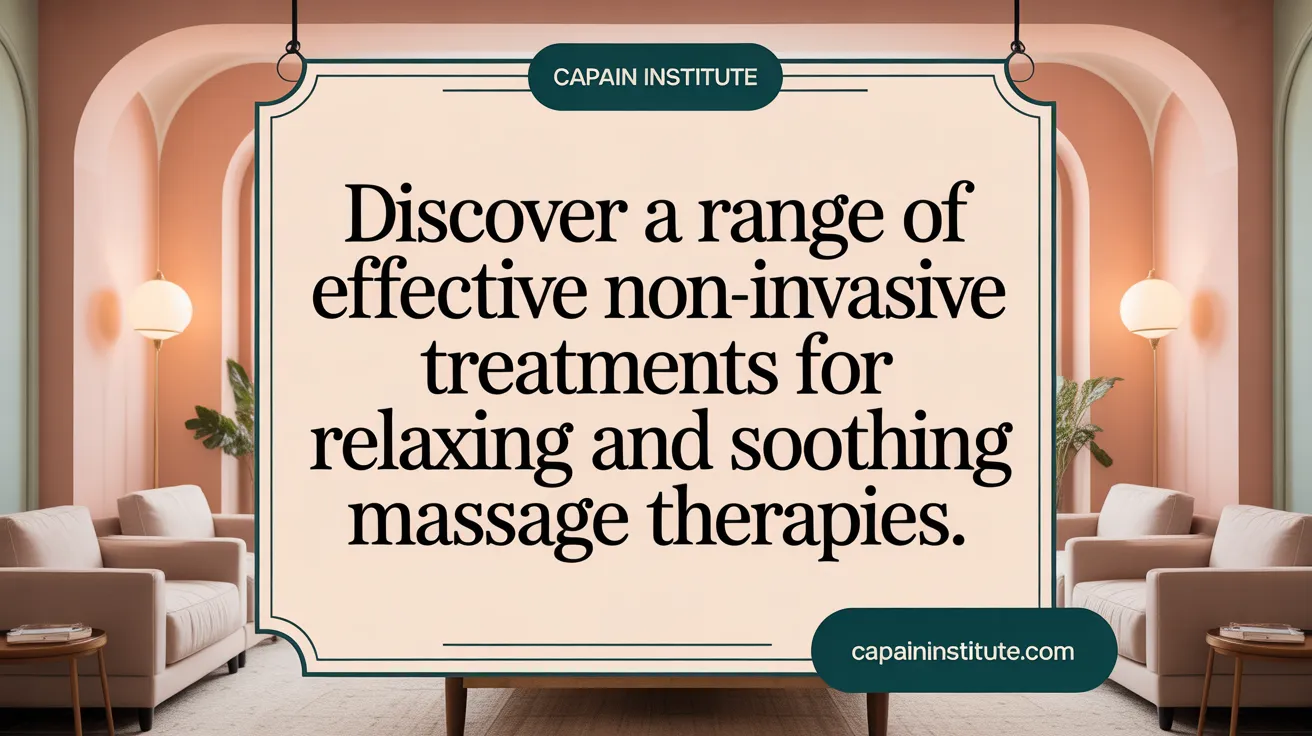Understanding Non-Surgical Pain Management
Chronic pain affects millions globally, significantly impacting quality of life and daily functioning. While surgery is sometimes necessary, many patients seek effective non-surgical treatments to manage pain and improve mobility without the risks associated with invasive procedures. This article explores a broad spectrum of evidence-based non-surgical interventions, focusing on physical therapies, mind-body approaches, lifestyle changes, and emerging treatments that offer relief and functional restoration for chronic pain sufferers.
<!-- VIDEO:eyJsaW5rIjoiaHR0cHM6Ly93d3cueW91dHViZS5jb20vd2F0Y2g/dj1RT3M0dlhYRVEtayIsImltYWdlVXJsIjoiZGF0YTppbWFnZS9qcGVnO2Jhc2U2NCwvOWovNEFBUVNrWkpSZ0FCQVFBQUFRQUJBQUQvMndDRUFBa0dCd2dIQmdrSUJ3Z0tDZ2tMRFJZUERRd01EUnNVRlJBV0lCMGlJaUFkSHg4a0tEUXNKQ1l4Sng4ZkxUMHRNVFUzT2pvNkl5cy9SRDg0UXpRNU9qY0JDZ29LRFF3TkdnOFBHamNsSHlVM056YzNOemMzTnpjM056YzNOemMzTnpjM056YzNOemMzTnpjM056YzNOemMzTnpjM056YzNOemMzTnpjM056YzNOLy9BQUJFSUFGTUFsQU1CSWdBQ0VRRURFUUgveEFBY0FBQUJCUUVCQVFBQUFBQUFBQUFBQUFBQUFRSURCUVlFQndqL3hBQTRFQUFDQVFNQ0F3WURCZ1FIQUFBQUFBQUJBZ01BQkJFRklRWVNNUk1pUVZGaGNUS0JzUWNVUWxLUjBTTmlvY0VWRmpSRGN1SHcvOFFBR0FFQUF3RUJBQUFBQUFBQUFBQUFBQUFBQUFFQ0F3VC94QUFnRVFFQkFBSURBUUVBQXdFQUFBQUFBQUFBQVFJUkF4SWhNVUVUSW9FRS85b0FEQU1CQUFJUkF4RUFQd0Mvc0FzdW4yNEFCL2hKOUJWVnEzRGVtMzNNMDFsRjJoL0dxQU5YSm91cll0b1Y1c2NxS01lV0JXaGh1bG1BeWQ2eXM5ZExCUjZGYTZRTGlPNGdqZTFsT1drZmZseDRIeUZVdDNvT2lUTVcwL1dJb1dQUkhrVjEvWElQMXIxUzZ0RWxUWVpyQzhRY05PaGVmVDEzNnRDUEgyL2F0OGVYYzFrNStUaXUrMFl2VWRObXNNRjVJSm8yNlNReUJoOC9FVnpKWGJPNUN1amN3WVpCVmhnZzF4b045cXBFT1dwbHFJVklwb0tseFNyUlJUSXBwcHBhUTBnU21tblVocEdaaW1sYytKcDVwS1ljc29JNXR5UUs5TXQvczAxR1hUNHBySzZ0SlJKRXNrWWFRSU1FQTc5YTg1bUcxZWk2RnhSMkdsV2NMeVNobzRVUTl3a2JESGhWOGVYV281TjJlT0s1K3pyaWhwQUk5THRYQUdPZGJpTTgyNVBqU1ZvUDg1d3JzMTJ5bnlaR0g5cVNyN3hudk5pTlV1THF4NGd1MXRtQVR1U01HWUJjTWl0azU2Ym1yL1N0Y2xLcjJxTW8zd1ZJWlNBTWtnand4V250NzdoTTJNSCtKcllUT3lLclBORUhPd0F5Y0tTQU05VFdvc3VDOVB0aksybldkbEVaVTVYeENBaktSMHh2c2ZIenJHOGMxNjJuUGNXYjA3Vm81bEFSd1JWc0lJcnFQcGsxeGNaYWZwR2l5SmVhckZjeVhNNmtLMWtHaVJRUHpNVHk1MzhSay9Lc2JiY1ZyYlNreFhDdkdEc0RJQ3dIcVFBRFdWNDcrTjhmK2pITDY3dUxlRVZ1UVo0TUxPT2o0Nis5ZWF0RTBSQmJCQkdReTdnajBQalhya2ZHVmhQYUtaVU1xTWVWZ3VOZ1IxMzI5Y0hyVkpOd2RiWE50TmNvcEJ1Q1hqSDRvMS9EbjF4MStwNjBUTHJQU3p4N1pmMWVmc01IRkEycXoxL1RaZE52QkhLb0dVVWdqT0RqYiszOWFxODFwTHY0enltcnFuNXBjMUhtak5OS1hOQnBpbW5Ha1pDYWFUVGpURFFCbWxGTnB3Tk1XR2taMnFYbkVYS3NpTXVWRERJNmc5RFRCV3ExeE5KdU9GTkJ4ZFJMcTBVWEswUTNKaUxOOFI4TUhjZTVvL1NaSzVmTWd3U05xS21uaUFsWVp6amJJNkdpZzl0NVk4Q2NRWDJuVzE1YjJlblN3VHdxOGJtN0hlVWpJT0NNVnRPRHJiaS9UTlVpWFdyN1RGMHdKeXlSdmNJejRWY0x5NFVZT3c2bnBYejkyOG9VS0pwQW9HQUE1d1BsVVpLazdnRStvcDk2bThlMzAzeG5wTnR4RkpaUER4RmJXZjNjU0t5TVZrVitZQVp4ekFaR05qNjEwMm1sY0l4V2x0RGNMb3R6TEJHcUdhUll1WnlBQmsrcHI1Wnd2Z3EvcFJ5ajhvL1NwNy9oZnhlZlgwZnhOd2J3L3JWeDk1c05XdDlQdUNBcmlKMGFOaGdENE03SEFBeU1lb05jQ1JmNE5kdllUVFJUeEVjME54R1JpUmZiSndSNGl2QWtSV0h3citsWFhEMDhtbVgwZHlJMk1EOTErUmZEeitWUmxqMmpUamx3djE2QjlvVmlrdWxpNUFHWW1CVmdQQW5CSDAvU3ZORDFyMTFwYmE1c3piM3B6Qkt2THpqcGcvU3NCeEJ3emRhWHpUd2szTm4xRXFqZFIvTVA3OUtqaXV2NjF0eVliOWlnb3BEUjFyWmllcHAyZHFZQWFYSG1RS0FYTklkK2xIUEdPbmVQcFNHYndWY1VFWEdPdEZJcFJqMUlQclQrWHlvQUdLVjJ1b2x6bk1ZSFJveHNQbUthQVEyS3VieVJJTk0zS00zSUZ4bllrN0dtSFh3NG5DbDNweGZYVGR3WGF5RlQyREFxNDJJYmNiZGNZOUtLMUgyZGZaN0JySERpNmpxbk5HYmlWbWdHRGt4QUFBL01oaVBUQm9xZDByY1hrZHZESmNTcEZHTXMyMWErQ3p0dE9zZWVmbENLT3VOM2J5ck02UmYvQUhDNUVvalZ6akdEVW1yYW5QcUVuTkxzbzJWVjJDMVVzeGg1UzI2YzE5Y0c1dUdrd0I0REE4SzU2VWJta0l4VUxTUjFNcGtUdnJ6QWVZMnFHSVZNa2tpZkJJNit4cHdOZndoeEJJWFhUcm1SWkkzMkVjdlNVWStFay84QWpXb250cHhtYlFMcGJhZFBqc2JnZHh2a2VueTJyeTVMbWRpcWhpeEpHQnlna210M1o2eXJXQmoxT0FUbUZjeWRtMlpJUjVnOWNlWTZqMXFNOGQreHJ4NS9sWXUrczdpMnVwSXJtSXdTNXlVSzR4bnk5S2c3Tmg0MWI4VHZCTmNRRzF2cGJxRHM4cHovQUJSRS9oejQxVUswaWVUaXJ4K01zNUpsNFRmenBRdVQzZ1NQU2w3U00vR0N0QVdJL0N4UHRUU2VCK1VqMklwK0Q1TFVYTEdPb2VuQW9Pbk1LQ1M5bUcySUZKeUJlaE9LYUg4aWFPYnpOTWlTSEFKOUtpZ2dsdW1NY0l5UU1ubU8xTmtrQkxJTng1MWNjTVF2TEZjTWd6Z2lpZTA3NUhYYmNROFphZmJ4MnRyckU4Y01TaFVRU0tRb0hRREk2VVZ4M3Q0c1Z3VVBVZGFLdnJFZjRaSlBiUjJnS2RtNzh1QUFQSEZWRjI1ZFVIUDNWMjVmRDNxVG5oaWpISXpTUGpiSXdCKzlRb3B3VGp1anpGWlZwSnBIMlpJeUtERzJPOXNmYnJVcGNnNVRiMm9NcjR3Y2ZwVWVxMlVSQllBKzJjNE85T1NMblVsU3ZNUHdsZ00xQ0dKTk9xOWt0Tkh0SlZ2bzVaSW1WRUJibTJJempBK3Y5S0wreXVyYVo1b3VZeHk1UE1EbnIxSHJVL0RjUTVMbWJBMktyOVRWeXFzdVRDL0xucXBHVlB5cDFGdXF5S3lzTmlBYW5rVHN4RzBxbE8xWG1RK1lxOXVJWUdKKzlXdkwvUEdPWWZ2VVV0amIzeGpIYXJpTmVWQXJnSEhzYW5zZTRwT1ZXR3pLYWFVWHpVVmNQdzZlcVNOODB6OUtqUEQ4dy8zby9ZcVJSMmh4V0R0RjZPaEhxYURKK2RSN2cxZHRwb2tzWTdMK0FzeVBreVk2amY1K05SRGg5bCtPNFFlMGY3a1V1OE5UbGxQVE5kR2xvczk0a1Uzd1B0N2V0WFZ2b1Z2bnZPOG4vRVlxemowNnpoUUJZZ3UrVDVuM05LNWxXT25zMjAyLzdLWUJ0Z3d4MFlFVkF2M20xbEFoZGxWMUxBcWZDdEx4REF0eEVIUUVTUUhKOVZQWDkva2FvN2k0aU1BQVR2b3BVSG04K3UxWGo2TjdWanV6dHpNeEpQaWFLYlJRcEorWDJxU04ySE1vWWdFWUlvb3BrZWcycEhBcGFLVkNMOFZQSFNpaWlHMG5EUDhBbzdvZUdjLzBydFNsb3AxbGZwNkVrNEoycHN0ckE2WmFNWm9vckkzQ3lpUGVNc3ZzeHBGbW1KQU0wblg4NW9vb04zMmtRbWIrSzhyZThyZnZYVEpid3hzRlNOUUtLS2tHQmlIS2duQThLWEo1U2MwdEZBY3VBMDVCM3pIdjY3Lzltc2Evd1A3MFVWcmg4R0xub29vcExmL1oiLCJ0aXRsZSI6IkhvdyB0byBtYW5hZ2UgY2hyb25pYyBuZWNrIGFuZCBiYWNrIHBhaW4gd2l0aG91dCBzdXJnZXJ5Iiwic25pcHBldCI6Ik5lYXJseSBvbmUgaW4gMTAgVS5TLiBhZHVsdHMgc3VmZmVyIGZyb20gY2hyb25pYyBuZWNrIG9yIGJhY2sgcGFpbiwgbGFzdGluZyB0aHJlZSBtb250aHMgb3IgbW9yZSwgc2lnbmlmaWNhbnRseSBhZmZlY3RpbmcgdGhlaXIgcXVhbGl0eSBvZiAuLi4ifQ== -->Exploring Non-Drug and Non-Surgical Therapies for Chronic Pain Relief

What are non-drug and non-surgical options for chronic pain relief?
For managing chronic pain without relying on medications or surgeries, a broad range of therapies exist that target different aspects of pain. Physical therapies such as physical therapy, massage, and acupuncture aim to restore mobility, relax muscles, and reduce inflammation. Techniques like transcutaneous electrical nerve stimulation (TENS) and joint injections are also useful for modifying pain signals.
Psychological approaches play a vital role and include cognitive-behavioral therapy (CBT), mindfulness-based stress reduction, meditation, and biofeedback. These methods help address emotional responses to pain, reduce muscle tension, and improve coping skills.
Mind-body practices such as yoga and tai chi combine gentle movement, breathing, and mindfulness, helping improve flexibility, balance, and relaxation. These practices not only alleviate pain but also enhance overall well-being.
Lifestyle strategies further support pain management. Regular exercise tailored to individual conditions can release endorphins, build strength, and improve function. Diet modifications promoting anti-inflammatory foods, along with weight management, can reduce strain on joints and tissues.
Incorporating these non-invasive, non-pharmacologic approaches offers effective ways to reduce pain and improve quality of life, often used alongside conventional treatments for comprehensive care.
Evidence-Based Alternative Techniques for Chronic Pain Management

What are some evidence-based alternative pain management techniques for chronic pain?
Several non-pharmacological, evidence-supported approaches can help manage chronic pain. Acupuncture is among the most studied, with research indicating it effectively reduces pain severity in conditions like back pain, headaches, and osteoarthritis. Some reviews suggest acupuncture can even lower the need for opioid medications and outperform sham treatments, supporting its role in integrated pain management.
Mind-body practices, including yoga, tai chi, and mindfulness meditation, have shown benefits in improving physical function, reducing pain intensity, and enhancing psychological well-being. Yoga has been especially effective for conditions like low-back pain and fibromyalgia, while tai chi is recommended for osteoarthritis of the knee and hip. These gentle movements, combined with breathing and meditation, help relax muscles, improve balance, and reduce stress hormones.
Manual therapies such as massage, spinal manipulation, and osteopathic manipulative treatment can provide immediate short-term relief for musculoskeletal pain. Massage therapy helps loosen tense muscles and improve circulation, beneficial for low back and neck pain. Spinal manipulation is a recommended option in guidelines for managing chronic low-back pain, with some patients experiencing significant symptom relief.
Psychological strategies like cognitive behavioral therapy (CBT), hypnosis, and neurofeedback are also supported by evidence. These treatments target emotional and cognitive factors influencing pain perception, improving coping skills and overall quality of life. CBT, especially when applied over multiple sessions, is effective for many chronic pain conditions.
In addition to specific therapies, lifestyle modifications such as regular exercise, healthy diet, stress reduction techniques, and applying heat or cold therapy can help lessen pain symptoms. Consistent physical activity, like walking or swimming, triggers endorphin release and maintains joint health.
Clinical guidelines recommend these approaches as safe, non-invasive options either alone or combined, fostering a holistic approach to pain management. They are particularly suitable as adjuncts or alternatives to medications, reducing reliance on drugs and associated risks.
More information search query
Research evidence supporting these therapies emphasizes their role in modulating nervous system activity, reducing inflammation, and improving functional outcomes. Scientific reviews affirm that acupuncture, yoga, tai chi, and manual therapy are valid components of comprehensive pain management programs, reducing pain scores and enhancing life quality for many patients.
Physical Therapy’s Vital Role in Pain Relief and Functional Restoration

What is the role of physical therapy in chronic pain management?
Physical therapy is a cornerstone of managing chronic pain, focusing on restoring mobility, reducing discomfort, and improving daily function. It employs various techniques such as stretching to improve flexibility, manual therapies like massage to relax muscles and optimize tissue health, and nerve stimulation to interrupt pain signals.
One of the main goals is to strengthen the muscles around affected joints or areas, providing better support and reducing strain that can cause or worsen pain. Strengthening exercises help enhance stability, improve posture, and reduce the load on injured or inflamed tissues.
In addition to traditional techniques, physical therapy integrates advanced interventional procedures. Nerve ablation, for instance, involves using heat to disable faulty nerve pathways transmitting pain. Spinal cord stimulation delivers electrical impulses to block pain signals before they reach the brain, offering relief for persistent, severe pain.
Photobiomodulation, also known as red light therapy, is an emerging approach where specific light wavelengths are used to reduce inflammation and promote healing.
These modalities work in concert to decrease pain, improve range of motion, and rebuild strength. They often are combined with supportive practices such as yoga, tai chi, and mindfulness techniques, which further aid in pain management.
Overall, physical therapy offers a non-invasive, drug-free pathway to lessen chronic pain and help patients regain their independence and quality of life.
Effective Nonpharmacologic Treatments for Chronic Pain Management
Managing chronic pain often requires approaches beyond medications. Several nonpharmacologic strategies have demonstrated effectiveness in providing relief and improving quality of life.
Heat and cold therapy are fundamental techniques used to reduce pain and inflammation. Applying heat relaxes tense muscles and increases blood flow, which can soothe sore areas and improve flexibility. Cold therapy, on the other hand, reduces blood flow, decreases swelling, and numbs painful nerves, making it particularly useful after injuries.
Massage therapy is another valuable option. By kneading and stroking soft tissues, massage eases muscle tension, promotes relaxation, and can temporarily relieve pain. Regular sessions may also help reduce stress levels, contributing to overall pain management.
Biofeedback utilizes electronic devices that monitor physiological responses like muscle tension and heart rate. Through real-time feedback, individuals learn to control these responses consciously, leading to reduced muscle tightness and pain. This method is especially beneficial for tension headaches, migraines, and back pain.
Mindfulness practices, including meditation and relaxation techniques, target the emotional and psychological components of pain. These practices help lower stress hormones, promote relaxation, and can decrease the perception of pain. Meditation encourages focused attention, helping individuals detach from pain sensations and manage their emotional response.
Psychotherapy, such as cognitive-behavioral therapy (CBT), addresses negative thought patterns, emotional distress, and fears related to chronic pain. It equips patients with coping skills and strategies to manage pain more effectively, thereby reducing its impact on daily life.
In some cases, electrical stimulation devices like TENS (transcutaneous electrical nerve stimulation) are used to send mild electrical currents to nerves, altering pain signals and providing relief.
While each of these approaches can be effective alone, combining them with other treatments often yields the best outcomes. Always consult healthcare professionals to develop a comprehensive pain management plan tailored to individual needs.
Lifestyle Modifications: Supporting Chronic Pain Management Without Surgery

How can lifestyle modifications support chronic pain management without surgery?
Adopting healthy lifestyle habits plays a crucial role in managing chronic pain effectively. Regular physical activity, such as walking, swimming, or practicing gentle yoga, helps strengthen muscles, increase flexibility, and reduce joint stiffness. These activities complement pain management and improve overall mobility.
Maintaining a healthy weight is also vital. Excess weight puts additional pressure on the spine and joints, worsening pain and inflammation. A balanced diet focusing on anti-inflammatory foods, like fruits, vegetables, and omega-3-rich options, can reduce inflammation and promote healing.
Stress reduction techniques, including mindfulness meditation, deep breathing exercises, and progressive muscle relaxation, help lower stress hormones that can amplify pain perception. Mindfulness-based approaches also improve emotional resilience and mental clarity.
Good sleep hygiene is essential for pain control. Adequate rest allows the body to recover and reduces sensitivity to pain. Pacing yourself throughout the day prevents overexertion, which can trigger or worsen pain episodes. Incorporating regular breaks and avoiding activities that aggravate symptoms are helpful strategies.
Furthermore, engaging in social activities, hobbies, and seeking emotional support from therapy or support groups enhances mental health. A positive social environment boosts overall wellbeing and can distract from pain, reducing its perceived severity.
Overall, these lifestyle modifications create a holistic framework that not only alleviates pain but also promotes a better quality of life without the need for surgical intervention.
Emerging and Innovative Non-Surgical Treatments for Chronic Pain

How are advanced electrical stimulation techniques being used?
New electrical stimulation methods, such as spinal cord stimulation and deep brain stimulation, are gaining traction in pain management. These devices send electrical currents to various parts of the nervous system to block or modify pain signals. TENS (Transcutaneous Electrical Nerve Stimulation) is a non-invasive version that is widely used for nerve-related pain, providing relief by disrupting pain signals at the nerve level. More sophisticated systems can be implanted to target specific pain pathways, offering longer-term relief.
What is radiofrequency ablation and how does it work?
Radiofrequency ablation (RFA) uses high-frequency radio waves to generate heat and selectively damage nerves that transmit pain signals. This procedure is effective for conditions like joint pain, neck pain, and other localized pain sources. It is minimally invasive and can be repeated if necessary, providing long-lasting pain relief by disrupting nerve function temporarily or permanently.
How promising is stem cell therapy?
Stem cell therapy involves harvesting stem cells from the patient's own bone marrow or fat tissue and injecting them into degenerated or injured tissues. This approach aims to stimulate tissue regeneration, reduce inflammation, and promote healing, which may alleviate pain in conditions like osteoarthritis. While still under research, early results suggest potential benefits, and it is viewed as a hopeful avenue for future pain treatments.
Which nutritional supplements are supported by evidence?
Certain dietary supplements, including omega-3 fatty acids, vitamin D, magnesium, and botanical options like turmeric and devil’s claw, have shown supportive evidence for reducing inflammation and pain severity. These supplements may help improve joint function and decrease discomfort, especially when combined with other therapies. It's important to consult healthcare providers before using supplements, as individual responses vary.
How is personalized pain management evolving?
Advances in personalized pain management involve utilizing molecular profiling, brain imaging, and psychological assessments to tailor treatments to each individual. This approach helps identify specific pain mechanisms and optimizes therapy choices, whether pharmacologic, interventional, or behavioral. Personalization aims to improve effectiveness, reduce side effects, and enhance overall quality of life for those suffering from chronic pain.
Tailoring Non-Surgical Treatments for Effective Chronic Pain Management
Managing chronic pain through non-surgical options requires a comprehensive, personalized approach integrating physical therapies, psychological support, complementary modalities, and lifestyle adjustments. Evidence supports many non-drug techniques such as acupuncture, massage, mind-body practices, and physical therapy that alleviate pain and restore function safely. Emerging technologies and integrative models promise further advances in personalized care. Collaborating closely with healthcare providers ensures that individuals select the most appropriate combination of treatments aligned with their pain condition and lifestyle. Ultimately, non-surgical strategies empower patients to improve quality of life and regain control over chronic pain without relying on surgery or opioids.
References
- 5 alternative treatments for chronic pain | UCLA Health
- 7 Ways to Treat Chronic Back Pain Without Surgery
- Non-Drug Approaches to Chronic Pain - Whole Health Library
- 8 non-invasive pain relief techniques that really work - Harvard Health
- Non-Opioid Treatment for Chronic Pain | Made for This Moment
- Chronic pain: Medication decisions - Mayo Clinic
- FDA Approves Novel Non-Opioid Treatment for Moderate to Severe ...
- Non-Drug Pain Management - MedlinePlus
- Noninvasive, Non-Pharmacological Treatments for Chronic Pain
